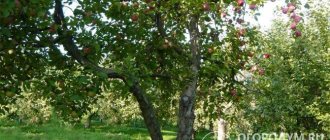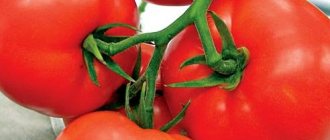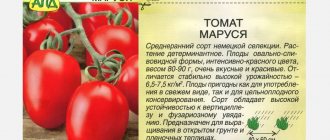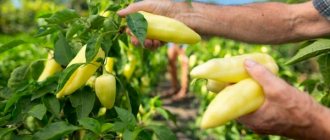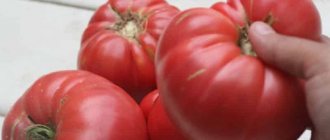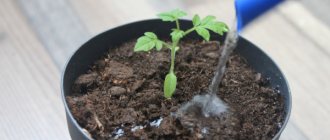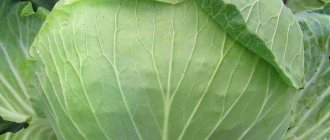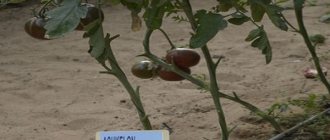- Preparing seedlings in open ground
Mid-season cabbage "Slava 1305" has been grown for more than 80 years, and all this time it has remained highly popular among gardeners. The variety is recognized as one of the best for fermentation, has excellent taste, and is valued for its versatility, productivity and reliability. Cabbage can be cultivated in all regions of Russia, both in private plots and on farms on an industrial scale.
“Slava 1305” is one of the achievements of domestic selection, well adapted to the climatic conditions of different Russian regions
The main characteristics of the variety can be found by looking at the table:
| Parameter | Characteristic |
| Culture | White cabbage (Brassica oleracea L. convar. capitata (L.) Alef. var. alba DC.) |
| Variety | "Slava 1305" |
| Ripening period | Mid-season |
| Period of achieving technical ripeness | 101-132 days from the moment of emergence (according to the State Register); 100-130 days after planting seedlings (according to the manufacturer) |
| Productivity | Marketable – 570-930 c/ha, maximum – 1250 c/ha |
| Head weight | 2.4-4.5 kg (as described in the State Register of the Russian Federation); 3-5 kg (according to information from the originator) |
| Appearance | The shape of the head of cabbage is round or slightly flattened, the leaves are of medium size, green or gray-green with a slight or medium waxy coating. |
| Taste qualities | Excellent |
| Purpose | Universal: for fresh consumption and pickling |
| Shelf life | 2 months |
| Sustainability | Heads of cabbage are resistant to cracking |
| Year of registration in the State Register of the Russian Federation | 1940 |
| Recommended growing regions | All (Northern, Northwestern, Central, Volga-Vyatka, Central Black Earth, Middle Volga, North Caucasus, Ural, Lower Volga, East and West Siberian, Far Eastern) |
| Originators | Federal State Budgetary Institution "Federal Scientific Center for Vegetable Growing" (Moscow region); LLC Agro (Moscow); Nasrullaev Niyazi Mehyeddin (Odintsovo); LLC Agro (Moscow region); Intersemya LLC (Stavropol Territory) |
Description of variety 1305
Slava 1305 (Brassica oleracea var. capitata) – white cabbage. The variety was bred a long time ago and has an average ripening period. It takes 130 days from emergence to harvest. The variety has good shelf life, is resistant to cracking and produces a yield of up to 12 kg per 1 square meter of area.
Cabbage Slava - characteristics:
- the diameter of the head of cabbage reaches 25 cm;
- round, slightly flattened shape;
- the weight of the head of cabbage reaches 4.5 kg;
- the upper leaves have a light green tint;
- the flesh is almost white.
Care
It is necessary to ensure that spring frosts do not harm the plants. If the weather forecast indicates the possibility of frost, you need to water the plants, since wet soil retains heat well. It is useful to cover the plants with polyethylene, but so that the film does not touch the seedlings.
“Slava 1305” cabbage needs to be watered infrequently, but abundantly, at the rate of 20 liters of water per square meter of plot. The number of waterings is no more than 8 during the entire growing season. If you water more frequently, the forks will crack. Two weeks before harvesting cabbage, stop watering.
Important! If you notice that the head of cabbage is cracking, twist it around its axis a little. Having lost some of the small roots, the plant will not absorb water as actively.
After watering, the Slava cabbage is hilled up. By doing this you achieve several goals: you remove weeds and improve the oxygen supply to the roots.
Photo
Look at the photo below to clearly understand what this variety looks like in order to distinguish it from others.
Distinctive features
This variety is very different from the others in the following characteristics:
- unpretentious in agricultural technology;
- resistant to diseases and pest attacks;
- tolerates lack of moisture well;
- high productivity;
- versatility in use;
- long storage period.
On a note. In addition, thanks to the shape of the head and the structure of the leaves, Slava cabbage is not susceptible to cracking. Therefore, it withstands transportation perfectly.
Market traders are very fond of this variety of cabbage, since the head of cabbage retains its presentation for more than three months, if properly stored. When grown on a personal plot, every gardener can enjoy salad from fresh cabbage until winter.
Advantages and disadvantages
Initially, the variety of this cabbage was bred for the non-chernozem part of our country, since it plays an important role for Russia. In many reference books describing Slava 1305 you can read exactly this information in the description of the variety. In these areas, the soil is poorly saturated with humus, but it rains very often, which contributes to the rapid ripening of the crop. But over time, it became clear that Slava tolerates dry periods well, so it began to be grown in all regions.
The advantages include indicators such as:
resistance to low temperatures;- practically does not form flower stalks;
- excellent taste in any form;
- high yield.
Like any crop, Slava cabbage has its downsides:
- high susceptibility to root system disease - clubroot;
- often affected by vascular bacteriosis;
- it cannot resist Fusarium wilt.
But if you choose and prepare the seeds for planting correctly, treating them with modern preparations, then these troubles can be avoided.
Reviews from vegetable growers
Do you want cabbage, like your mother and grandmother did? Look for the cabbage “Slava” - so flattened at the poles, and you will be “happiness”.
Kalyusya
https://hlebopechka.ru/index.php?option=com_smf&Itemid=126&topic=186567.60
I plant Slava 1305 on the plot every year. The heads of cabbage are good, strong, and do not get sick.
Galina
https://www.dacha6.ru/kapusta-belokochannaya-slava-1305-otzyvy-opisanie-foto/
I grow the variety Slava 1305 every year. Everything suits me. The seeds germinate well and the seedlings take root well after transplantation. Once I bought a bag of seeds, but they turned out to be expired. I was afraid to sow in the ground - I first soaked it in wet gauze. After a couple of days, almost all the seeds sprouted. Needs abundant watering and loosening. It responds well to feeding with mullein infusion (1 cup per 10 liters of water) and hilling. It grows on all types of soil, but soil rich in humus is preferred, then it is especially juicy and the heads of cabbage are larger. It stands in the fall for a long time without cracking. I take it off with the first snow, but it doesn’t freeze, so it can be stored for a long time. Delicious in borscht, salads, cabbage rolls. It’s good for pickling if you salt with dry salting rather than pouring it with ready-made brine (my subjective opinion)
Catherine
https://sortoved.ru/blog_post/sort-kapusty-slava-1305
I sowed cabbage “Slava” for seedlings, today a neighbor came and upset me... she says it’s a bad variety, you can’t ferment it...
gallatro
https://otzovik.com/review_930807.html
Cabbage "Slava" goes well for pickling. Her forks are large, juicy and white. Previously, only such cabbage was planted. We didn’t store it much, we mostly fermented it. Cabbage is delicious. In winter I just ate whole pieces.
Gordienko Sveta
https://otzovik.com/review_930807.html
Every year we sow cabbage seeds in our garden, both early and late ripening. Definitely “Glory”. Last year we bought and decided to try seeds of the “Slava 1305” variety. The heads of cabbage grew not just big, but simply huge. The taste is also excellent. And most importantly, it has a surprisingly long shelf life.
Lorida
https://otzovik.com/review_426133.html
Many vegetable growers value Slava cabbage for its good taste, rapid ripening, and high yield. And if you successfully overcome all the difficulties of growing and caring for them, neat heads of cabbage will delight your owners all fall and even longer.
- Author: Diana Nikiforova
I never cease to be convinced that life is wonderful. Rate this article:
- 5
- 4
- 3
- 2
- 1
(11 votes, average: 4.5 out of 5)
Share with your friends!
Similar varieties
Let's consider mid-season varieties of white cabbage, which have the same characteristics as Slava in terms of yield and taste.
Belorusskaya 455
An ancient and quite popular variety. It is stored for a long time, does not crack and has good taste when fermented. The weight of one fork reaches 4 kg, the mass is dense and tasty.
Hope
Cabbage was bred by domestic breeders and is very productive. Biological maturity occurs at the end of August, harvesting occurs at the onset of the first frost. Long shelf life - until February. Fork weight – 3.5 kg. per square meter of area you can collect up to 12 kg.
Rinda F1
The hybrid is sectioned in Holland. This mid-season variety can be stored for a long time directly on the vine. It has white-yellow inner leaves. The variety is universal, good both fresh and prepared. The average yield is 9 kg per square.
Present
The variety was bred in 1960. A distinctive feature of the Podarok variety is resistance to diseases. The heads of cabbage reach 4.5 kg, are dense and do not crack. Suitable for pickles. From a square you can collect 10-11 kg.
Megaton F1
A productive, mid-season hybrid of Dutch breeders (read about other varieties of cabbage of Dutch selection here). Resistant to all types of diseases to which cabbage is exposed. Tolerates light frosts. A high-yielding variety, since with proper agricultural technology the heads of cabbage can grow up to 10 kg. It stores well until February and has an excellent presentation (what other varieties are suitable for winter storage?).
Agrotechnical recommendations
Mid-season varieties include varieties of crops with a ripening period of 115-150 days from the moment of emergence; a head of cabbage has time to form in them in a relatively short time. This type of cabbage is usually grown in two ways: the first is by cultivating seedlings in open ground, and the second is without seedlings.
Preparing seedlings in open ground
Areas with fertile soil, well-lit by the sun and protected from the wind are best suited for growing seedlings. The place for the nursery needs to be prepared in the fall: add organic fertilizer (compost or manure) at the rate of 10-15 kg/m2, as well as lime (on acidified soils - up to 500 g/m2). After this, the ground is dug up and beds are formed, which are mulched on top with a layer of humus or manure.
Seed material is offered by many well-known agricultural manufacturing companies.
In the spring, as soon as the snow melts (in late April - early May), the soil is leveled with a rake and sowing begins. On the bed, grooves are made 0.5-1 cm deep with a distance of 10 cm from each other. Seeds are sown in them (two or three at a time) at intervals of about 2 cm, planted, slightly compacting the soil, and sprinkled with a layer of peat or humus. If it is hot outside and the soil is dry, the bed must be watered with cool water and mulched. To create a greenhouse effect, crops are sometimes covered with film.
Shoots appear in a week and a half. When the cotyledons open and the true leaf sprouts, it is necessary to thin out the weak shoots from each hole, leaving the strongest ones.
Many gardeners prefer to prepare seedlings at home, and with the onset of stable heat, they immediately plant them in a permanent place
The first feeding is carried out when the second true leaf appears. Plants are fertilized with ammonium nitrate solution. To prepare it, 20-30 g of saltpeter are diluted in 10 liters of water. This volume is enough to water 1 m2. The nutrient solution is applied under the roots, being careful not to get on the leaves. If the soil is dry, the beds must be watered first. The next feeding is carried out with a complex fertilizer such as “garden mixture” (NPK - 6: 9.8: 9.4) a week before transplanting the seedlings. 30-40 g of fertilizer are diluted in a bucket of water (per 1-1.5 m2).
When each plant has 4-5 true leaves, the seedlings can be transplanted to a permanent location. It is recommended to water it well the night before so that the plants can be easily removed from the soil without unnecessary injury to the root system.
The area for planting cabbage seedlings is also prepared in the fall: compost or manure (4-6 kg/m2) is added and dug to a depth of 20 cm. In the spring, while the seedlings are growing, it needs to be weeded, and a week before planting, again dig up, loosening the soil well.
Usually grown seedlings are transplanted in early June, planting pattern: 60x50 cm or 70x60 cm
The transplanted plants are watered, and the wet holes are sprinkled with dry soil on top. In the future, cabbage needs to be fed with nitrogen and complex fertilizers, irrigated as needed and protected from pests.
Seedless method
This method is less labor-intensive - it is convenient because the seeds can be immediately sown in the beds in a permanent place, while the heads of cabbage ripen about 10 days earlier.
The holes are formed with a depth of approximately 0.5-1 cm and several seeds (3-4 pieces) are placed in each hole. The interval between the holes is 50-60 cm, and a distance of 60-70 cm is left between the rows. A mulching layer of peat is poured on top or humus.
Before sowing seeds, prepare the soil in the same way as for growing seedlings in open ground.
As a rule, friendly shoots appear on the 7-10th day. When the cotyledons open and the first cotyledon leaf forms, it is necessary to thin out the weak seedlings and leave the strongest ones for further growth. Next, you need to provide the plants with fertilizing and soil moisture. To prevent water from evaporating too quickly, it is recommended to loosen after each watering or rain.
Curling of heads of cabbage begins after August 15th. At this stage, plants especially need moisture, especially if the weather is dry, the beds need to be watered, but not too often. The harvest is usually harvested in mid-October, before frost sets in.
How to distinguish from other species?
Important! It is very difficult to distinguish the seeds of one cabbage variety from another. Do not purchase planting material from your own hands; it is better to go to a special store to buy it.
Examine the packaging carefully; it should be marked with an expiration date and the grade must be determined. It must be remembered that the shelf life of seeds cannot exceed 4 years. It is better not to buy expired seeds, as they may simply not germinate.
If cabbage is bought at the market as ready-made seedlings, then you can only distinguish whether it is an early variety or a late one. For example, in early varieties the leaves are almost emerald in color, and their bushes are small and squat.
Late varieties, which include cabbage Slava, have a darker, slightly bluish color of foliage, which is located on an elongated bush.
Read more about types of cabbage here.
There is a huge variety of cabbage varieties: Vestri F1, Nozomi, Romanesco, Kale, Mirror F1, Centurion F1, Kolobok, Sugarloaf, Moscow late, Valentina.
Harvesting
Slava can be cut when the weight of the head reaches 0.5 kg. This happens in the second half of July. Harvesting may take two weeks or more. If the stalk is left in the ground after cutting the fruit, then by autumn small heads of cabbage will form on it, which are suitable for eating.
After harvesting, the cabbage should be dried and the damaged top leaves should be torn off. Some of the fruits can be fermented, the rest can be stored in the cellar. The storage room should also be dry; treating the walls and shelves with an antiseptic will prevent the formation of mold and rotting.
Heads of cabbage of medium size, medium-sized, dry, without visible damage, without cracks are best stored. When storing cabbage, you should not mix several varieties, since the fruits have different shelf life, and the rotting area can spread to neighboring heads of cabbage. Optimal humidity is 90–95%, temperature is 0°C; in warmer air the cabbage will begin to germinate, and in low air it will freeze, and when thawed the core will darken.
Methods for storing cabbage in the cellar
- Hanging - for this method you need to leave the stalks with roots. Drive nails into the timber under the ceiling and hang the heads of cabbage on them with their roots up so that they do not touch each other.
- In boxes - cut off all the stalks and put them in boxes with holes.
- Pyramid - place heads of cabbage on a wooden stand in a checkerboard pattern, large ones at the bottom, small ones at the top.
- Under the sand, place the cabbage in boxes, cover each layer with sand.
- In paper or film - wrap each head of cabbage in several layers of paper (it’s better not to use newspaper) or cling film.
One way to store cabbage is by hanging the heads of cabbage.
Video: cabbage varieties for pickling
What is it used for?
This variety of cabbage is widely used due to its excellent taste , for example:
- Fresh cabbage is used to make various salads; it can be fried and stewed with various ingredients. The variety of salads will ensure that you will not repeat it even once during the entire growing season.
- Cabbage is good in borscht and pickles; it makes cabbage soup that tastes great.
- Slava makes excellent salads for the winter; it is pickled, fermented, and also used for pickling.
Our ancestors used cabbage not only as food, but also as medicine. For example, cabbage leaves were used to wrap sore joints. And the steamed vegetable was used to treat stomach and intestinal colic. It's no secret that sauerkraut juice is used as a drink after wild parties to relieve hangover symptoms.
Every year, gardeners come up with new ways and recipes that include this healthy and tasty product.
